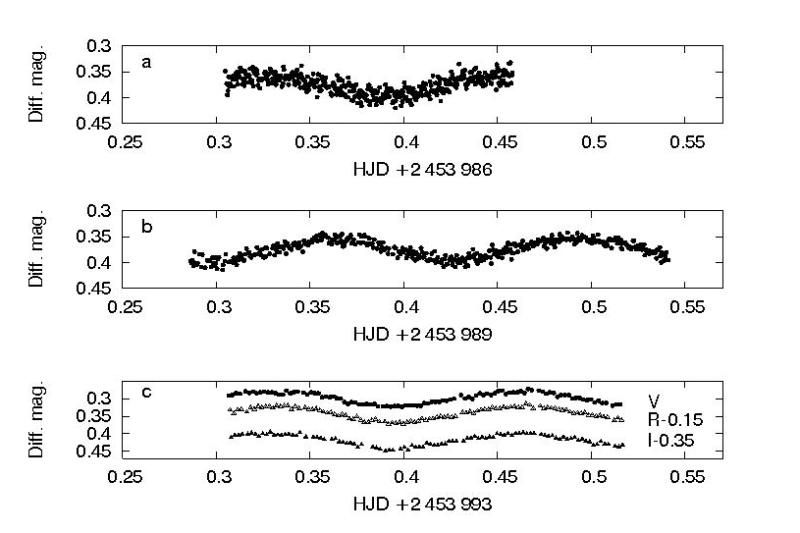"Peremennye Zvezdy",
Prilozhenie,
vol. 7, N 5 (2007)
Prilozhenie,
vol. 7, N 5 (2007)
A new variable in Cassiopeia
P. Klagyivik#1, S. Csizmadia#2, A. Moor#2, A. Pal#1
#1 Astronomical Department of Eotvos University, H-1518 Budapest, P. O. Box 32.,
Hungary
#2 Konkoly Observatory of the Hungarian Academy of Sciences, H-1525 Budapest, P.
O. Box 67., Hungary
#2 Konkoly Observatory of the Hungarian Academy of Sciences, H-1525 Budapest, P. O. Box 67., Hungary
Received: 14.10.2006; accepted: 26.02.2007
(E-mail for contact: P. Klagyivik@astro.elte.hu, csizmadia@konkoly.hu, moor@konkoly.hu, A.Pal@astro.elte.hu)
| ||||||||||||||||||||||
Remarks: |
| During the minimum observations of CW Cas we found that one of the stars in the field
is variable, too. We used the recently installed 40cm RC telescope of the Astronomical
Department of the Eotvos University for measuring minima times of some selected eclipsing
binaries. This telescope has a 4kx2k SBIG STL-11k electronically cooled CCD camera
and it is located in the light-polluted down-town of Budapest at the bank of the
river Danube. The CCD-frames were bias- and dark-subtracted as well as flat-fielded.
Dome
flats were used. The raw magnitudes were extracted by the IRAF/DAOPHOT packages using
aperture photometry. The aperture was chosen as 2xFWHM of the stars. Then differential
magnitudes were formed. V magnitude in maximum was determined relatively to one of
stars in the same field, HD 4101 and ALS 6336, whose standard magnitudes were taken
from
the SAO catalogue and from Haug (1970) respectively.
The light curves relative to the comparison star obtained the discovery night and three nights later can be seen in the Figure. The comparison star is denoted in the Finding chart. The new variable has the designation TYC 4020 00609 1. Its variability was confirmed three nights later. Filtered observations were obtained by us using the 60/90/180 cm Schmidt telescope and a 1536x1024 electronically cooled CCD-camera. The reduction procedure was the same as described above. The amplitude of the variability was found to be 0.04 magnitude and it has a sinusoidal shape. Due to the short period (P=0.127 days as the Fourier-analysis showed) we suspect that it is likely a delta Scuti type variable. |
| References: |
| Haug, U., 1970, A&AS, 1, 35 |
Light Curve
Unfiltered light curves of the new variable obtained by the 40cm RC telescope (a, b), and VRI light curves of the new variable obtained by the 60/90/180cm Schmidt telescope (c). Finding Chart 
Finding chart of the new variable. The comparison star is also plotted. Data Source |